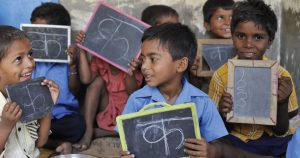 Soumya tells us about his involvement as a voluntary teacher with a group of marginalised and deprived children. Here’s a heart-tugging experience interspersed with humour. A Different Truths exclusive.
Soumya tells us about his involvement as a voluntary teacher with a group of marginalised and deprived children. Here’s a heart-tugging experience interspersed with humour. A Different Truths exclusive.
I have been staying in one of the greener parts of Delhi, which has a densely wooded area close by. This green oasis is teeming with birds and has a large number of peacocks. I go there every day for my morning walk, and do some light workout at an open air gym in a clearing in the woods, in a futile attempt to reduce my bulging waistline.
Although it has had no effect on my girth, I really enjoy my daily immersion into nature, when I can forget that I am in a bustling metro.
I noticed that on Sundays, a school of some kind was being run under a copse of trees, which has a circle of benches, occasionally occupied by people doing breathing exercises or gossiping on other days of the week.
Intrigued, I walked up to the group, and observed that a bunch of about thirty children of all ages, from toddlers to teenagers, of both sexes, obviously from the more deprived sections of society, were being coached in small groups by a few young people and a few senior citizens. After a while, some snacks were distributed to the children, and they left, chattering happily, and horsing around, as children are wont to do.
This was an informal tuition or coaching class for underprivileged children from the area, most of whom study in the municipal or village schools in the area and come from the neighboring village or the shanty towns of migrant labours.
I spoke to one of the teachers, and found out that this was an informal tuition or coaching class for underprivileged children from the area, most of whom study in the municipal or village schools in the area and come from the neighboring village or the shanty towns of migrant labours, or are children of the domestic help of the well-heeled residents of our area. The teachers were all volunteers, either idealistic young professionals or retired professional men and women residing nearby. The food was also contributory, anyone who wanted would donate some items or pay for something basic like fruits or milk. But what they needed most was contributions of time, which is the most valuable and scarce item in these hectic  times.
times.
As the classes were not organised, and all ages were in a mixed group, plus given the propensity of children that age for creating mayhem, a mild description of the process can be called chaotic. Added to that was my imperfect knowledge of Hindi, the medium of instruction The practice of teaching in the municipal or village schools which these kids attended, was by rote. There was no attempt to understand the logic or the meaning, just memorize the steps or the words.
I attempted to teach them the unitary method by giving live examples of purchasing items in a shop, and everyone could do the mental maths immediately and even corrected me on the price of things I mentioned in my examples, but applying the same to their maths book problems was a challenge for most. Similar issues happened in trying to explain work & time and time & distance problems. A few of the kids were extremely sharp and would take pride in solving difficult fractions, long divisions etc. but appreciation expressed caused jealousy,
competition, acrimony and cheating.
Then again I had to scratch my head to remember the steps of solving HCF and LCM and methods we learnt seemed different from what they were being taught in school.
I tried to get the smarter children to demonstrate by solving the problem on the blackboard, but this resulted in a scrimmage and had to be abandoned.
In the process, I was learning a great deal.
The younger sister of a family was way better than most of the older children in senior classes and insisted like a young Sheldon of solving their problems as her own classwork bored her.
The girls were generally smarter than the boys and much more serious about studying and this was resented by the boys, especially the older ones.
I noticed that the girls were generally smarter than the boys and much more serious about studying and this was resented by the boys, especially the older ones. They would often refuse to share the bench with the girls of their class, but a few older ones were great admirers of an older girl who was somebody’s domestic help who used to bring her employers dog for a walk and briefly joined the class.
A few boys would gallantly offer to escort her back when her duty called, thus braving the ire of the teachers and missing the goodies at the end of the class. Their crestfallen faces broke my heart and I smuggled a few oranges to them later, which they generously shared with the lady with the dog.
I noticed the shortcomings of my teaching methods that my children never tire of pointing out, that is my impatience with those slow to learn.
There was a handicapped boy who had never been to school but who was extremely bright and very shy. There was a young lady who dedicated all her time to patiently teach him whenever she could come.
 Around Diwali time, most of the teachers who had been receiving gifts of dry fruit had brought some for the kids and it was all pooled together and distributed along with the usual milk, biscuits and bananas that was offered after class. Other than an occasional birthday of one of the teacher’s children when cupcakes or pastries were distributed, this was a major treat. The children instantly burst into an impromptu song, ‘kaju badam, bahut mahenga daam’ meaning dry fruits are very expensive. Some of them showed me the pistachios and asked me how to eat those.
Around Diwali time, most of the teachers who had been receiving gifts of dry fruit had brought some for the kids and it was all pooled together and distributed along with the usual milk, biscuits and bananas that was offered after class. Other than an occasional birthday of one of the teacher’s children when cupcakes or pastries were distributed, this was a major treat. The children instantly burst into an impromptu song, ‘kaju badam, bahut mahenga daam’ meaning dry fruits are very expensive. Some of them showed me the pistachios and asked me how to eat those.
I had also managed to involve some of my colleagues staying with me in the guest house into this venture as the shortage of teachers was deeply felt.
As they got to know me better, I graduated from Sir to Uncle and they asked personal questions about my name and work. They wondered why I was not fluent in Hindi and I explained that I was from Bengal. One of the boys got excited as they had heard of ‘Bengal ki Khari’ which is what the Bay of Bengal was called in Hindi. This boy being from the hills had seen creeks and gorges and had imaging the Bay of Bengal to be a narrow crack in the land. So I got a map and showed him the large bay and tried to explain what a sea was and that it was the same size as the Arabian Sea which they had often seen in the films.
This lead to the discussion on various things in the map and they excitedly pointed out islands which they had read was surrounded by the Sea. They noticed Sri Lanka and Australia were an island and quite logically wondered whether there were any people there, and if so how they reached there and what did they eat. Another boy pointed out that unless there were people, who were well fed, how they would have cricket teams.
This interesting debate moved on to the existence of ghosts and spirits and they discounted my skepticism by insisting that they have all witnessed paranormal activities in the villages and that ghosts did not come to the city.

I don’t know how this interesting debate moved on to the existence of ghosts and spirits and they discounted my skepticism by insisting that they have all witnessed paranormal activities in the villages and that ghosts did not come to the city.
I knew I was accepted when one of the kids smuggled a spicy snack for me and gave it to me when no one else was looking I have since moved out of my guesthouse into a flat in a different location and I solely miss my Sunday morning interaction. I don’t know if I helped them in any way or taught them anything useful but I got so much back from the exchange that I felt deeply enriched.
©Soumya Mukherjee
Photos from the Internet






 By
By
 By
By
 By
By